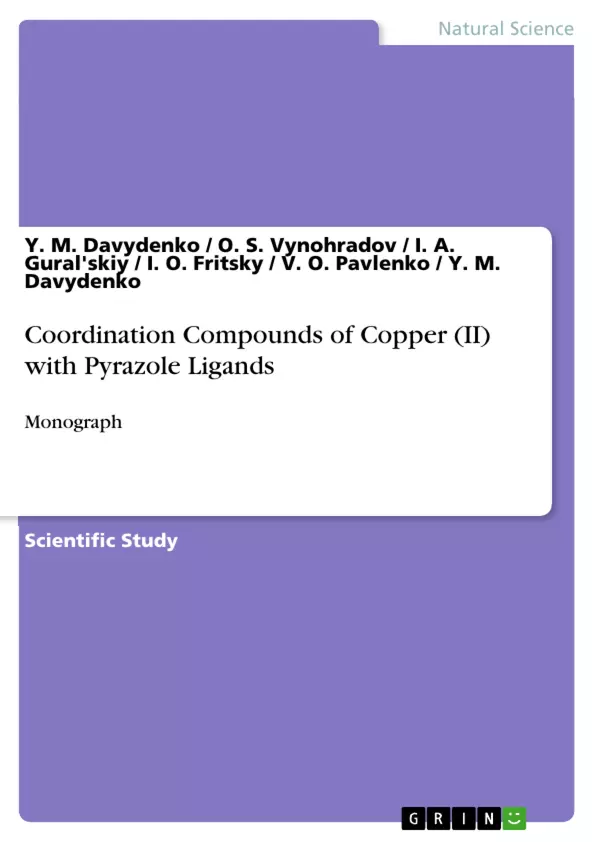The monorgaph is dedicated to the development of a new approach to the synthesis of multinuclear copper compounds, which consists in oxidative dissolution of copper powder in the presence of copper(II) halides in non-aqueous solution of organic ligands on air. The difference of the proposed approach from the widely used direct synthesis with ammonium salts is the use of copper(II) halides, which simultaneously act as a controlled source of anions and a primary oxidant of metallic copper. The optimal conditions for the synthesis of copper(II) pyrazole-containing complexes were selected. It was shown that the optimal molar ratio between reagents for the synthesis of µ3-oxocentric trinuclear copper(II) pyrazole-containing complexes is 1:1:2 (copper:copper(II) halide:pyrazole ligand). The final products are formed after the stage of formation of known trinuclear copper(I) compounds. The formation of mainly tetranuclear compounds [Cu4(µ4-O)(µ2-X)6(L1)4] (X – Cl, Br; L1 – 3,5-dimethyl-1Н-pyrazole, 1Н-pyrazole) occurs when the molar ratio is changed to 1:2:3. Most of the first synthesized coordination compounds have a molecular structure and consist of neutral particles. X-ray powder diffraction confirms the crystalline nature of some analyzed samples and the formation of individual compounds. Thermogravimetric analysis of some compounds showed that these complexes are stable to a temperature of 100 ˚С.
Inhaltsverzeichnis (Table of Contents)
- Coordination Compounds with Pyrazole Ligands
- Investigation of the peculiarities of oxidative dissolution of metallic copper in the presence of Cu2+ ions in non-aqueous solutions of pyrazole ligand
- Structure of the pyrazole-containing coordination compounds К1–К8
- Structure [Cu(Hpz)2Cl2](К1)
- Structure [Cu(Hdmpz)3Br2] (К2), [Cu2(µ2-Br)(µ2-4Br35dmpz)(Hdmpz)4Br2]ꞏ2CHCl3 (К3), [Cu3(µ3-OH)(µ2-Br)3(µ2-4Br35dmpz)(Hdmpz)5Br]ꞏCHCl3 (К4)
- Structure of trinuclear metal-cyclic complexes [Cu3(µ3-OH)(µ2-Cl)(µ-Ipz)3Clꞏ2CH3CN]2 (К5) та [Cu3(µ3-OH)(µ2-Br)2(µ-Ipz)3]n (К6)
- Structure of tetranuclear complexes [Cu4(µ4-O)(µ2-Br)6(Hpz)4] (К7) та [Cu4(µ4-O)(µ2-Cl)6(Hdmpz)4] (К8)
- Brief conclusions
Zielsetzung und Themenschwerpunkte (Objectives and Key Themes)
This monograph investigates the synthesis and structural characterization of copper(II) coordination compounds with various pyrazole ligands. The primary objective is to understand the influence of starting material composition and synthesis conditions on the resulting multinuclear complexes. This includes exploring the oxidative dissolution of metallic copper and optimizing crystallization techniques.
- Oxidative dissolution of metallic copper in the presence of pyrazole ligands.
- Influence of starting reagent ratios on complex composition and structure.
- Structural characterization of mono-, bi-, tri-, and tetranuclear copper complexes.
- Crystal structure analysis and Hirshfeld surface analysis of the synthesized complexes.
- Correlation between synthesis conditions and resulting complex geometries.
Zusammenfassung der Kapitel (Chapter Summaries)
Chapter 1 explores the oxidative dissolution of metallic copper in various solvents and with different molar ratios of starting reagents. The study investigates the effects of solvent choice (acetonitrile, methanol, DMF) and the presence of water on the reaction process and product formation. Different crystallization methods are also compared.
Chapter 2.1 details the synthesis and structural analysis of the mononuclear complex [Cu(Hpz)2Cl2] (K1), including its IR spectrum, coordination geometry, and crystal packing. Intermolecular hydrogen bonds and Hirshfeld surface analysis are discussed.
Chapter 2.2 describes the isolation and structural characterization of three complexes (K2, K3, K4) from a Cu - CuBr2 - Hdmpz - CH3OH system. The different coordination geometries (trigonal bipyramid, square pyramid) are analyzed, along with their respective IR spectra, crystal structures and Hirshfeld surface analyses.
Chapter 2.3 focuses on the synthesis and structural elucidation of two trinuclear metal-cyclic complexes, K5 and K6, using 4-iodo-1H-pyrazole. Thermal analysis (TGA and DTA) data are presented, along with detailed descriptions of their crystal structures and Hirshfeld surface analysis. The formation of dimers and polymeric chains is discussed.
Chapter 2.4 discusses the synthesis and structural characterization of two tetranuclear complexes, K7 and K8, featuring a Cu4(µ4O) core. The study compares their structures, including coordination geometries and crystal packing, supported by IR spectroscopy, TGA analysis and Hirshfeld surface analysis.
Schlüsselwörter (Keywords)
Copper(II) coordination compounds, pyrazole ligands, oxidative dissolution, multinuclear complexes, crystal structure, X-ray diffraction, Hirshfeld surface analysis, coordination geometry, mononuclear, binuclear, trinuclear, tetranuclear, metal-cyclic complexes, azametallacrowns.
- Quote paper
- Y. M. Davydenko (Author), O. S. Vynohradov (Author), I. A. Gural'skiy (Author), I. O. Fritsky (Author), V. O. Pavlenko (Author), Y. M. Davydenko (Author), 2024, Coordination Compounds of Copper (II) with Pyrazole Ligands, Munich, GRIN Verlag, https://www.grin.com/document/1508817



